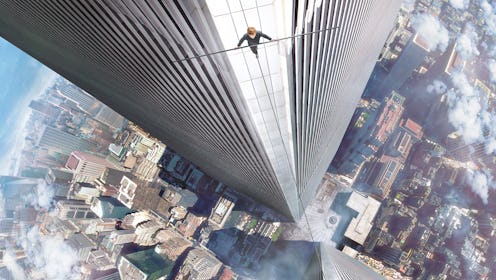
Philippe Petit's high-wire walk between the World Trade Center towers earned him a place in history — not to mention an on-screen legacy, thanks to the documentary Man on Wire and the new Hollywood blockbuster The Walk. But did you know it also earned him a pair of NYPD handcuffs? In 1974, after the then-24-year-old stepped down from his tightrope, he was immediately taken into police custody and arrested. Photos show he addressed reporters outside Beekman Downtown Hospital in handcuffs. Petit was later charged with disorderly conduct and criminal trespassing. Those charges were dropped by Manhattan District Attorney Richard H. Kuh in exchange for a free performance in Central Park — this one entirely legal. The famous acrobat and street performer may have escaped the wrath of the law in 1974, but what about Petit's other arrests?
Over the course of his decades-long career as a street performer and performance artist, Petit's stunts have varied in both scope and legality. Since his infamous walk across the Twin Towers, many of his larger stunts have been done within the confines of the law, including a tightrope walk over the Seine from the Palais de Chaillot to the Eiffel Tower in Paris. Still, Petit has reportedly been arrested over 500 times. Surprisingly, a majority of those 500 arrests occurred while he was juggling on the street in Paris, according to the performer himself. As he revealed to The New Yorker in 1999, he would set up shop on a sidewalk outside the Café les Deux Magots not far from Notre-Dame in Paris. There, he would create a stage by tracing a circle in chalk and perform a juggling act, presumably without a permit, hence the multiple arrests.
Petit's most famous arrest prior to his move to New York occurred in 1971, when he decided to set up a tightrope over Notre Dame (pictured above). "One day, I decide that I am going to put a wire there, and surprise Paris, surprise the world." Petit sneaked up to the top of the towers of Notre Dame one morning in June and attached a tightrope across the very top. He went across the wire a few times, dazzling Parisians with elaborate walks and a juggling act — all performed many feet above the ground. Petit may have been the talk of Paris for a few hours, but after he came down, he was arrested, and failed to receive the notoriety he was looking for. It was a few years later that he turned his attention toward New York City.
Petit's public stunts became more legal as time went on, particularly after the his walk across the Twin Towers made him a household name. He did, however, get arrested once again in New York City years later in 1980, after he set up a walk over St. John the Divine, the Gothic cathedral in Morningside Heights. After he was arrested for trespassing, Dean James Parks Morton, the Dean of the cathedral, vouched for Petit. "He wasn't trespassing. He is an artist of this cathedral," Morton reportedly told the police. Petit has been an artist-in-residence at the cathedral since then.
Petit's desire to execute elaborate stunts doesn't seem to have diminished. Instead, the reason for his increasingly legal stunts seems to be society's more gun-friendly attitude. As Petit's manager and partner, Kathy O'Donnell, put it in a recent interview with The Daily Beast, if Petit tried anything like his 1974 stunt today, "It wouldn't be like then. Let's wait for the guy for 45 minutes to come in off his wire. It would be bye bye!"
Just because Petit has put his more extreme stunts behind him doesn't mean the acrobat has stopped entertaining. Petit still practices walking the wire for hours every day, and has vowed to perform until his body is no longer able.